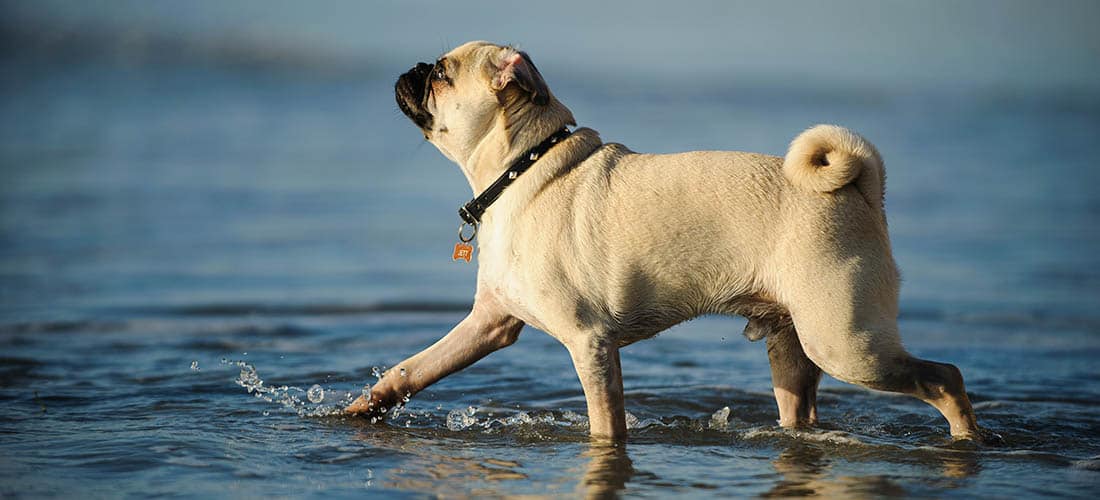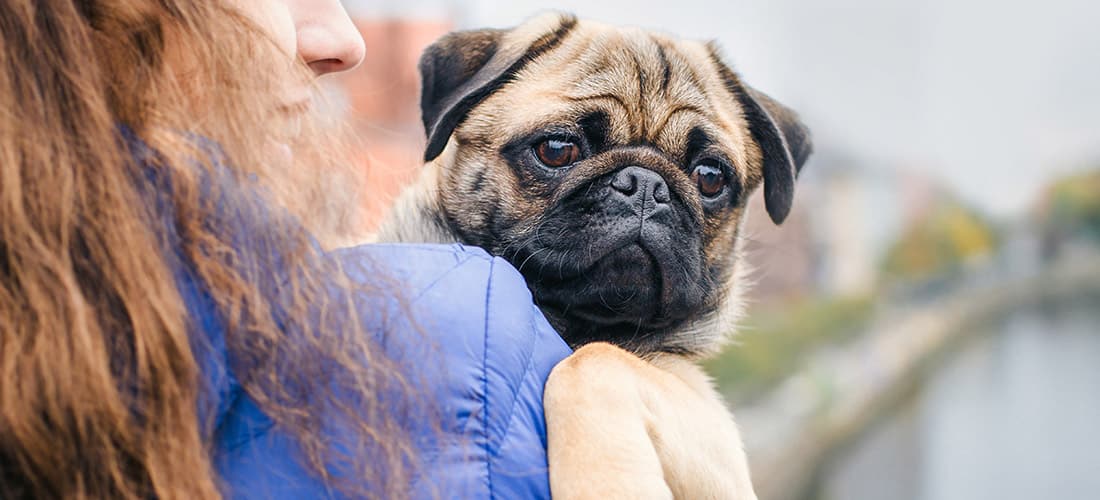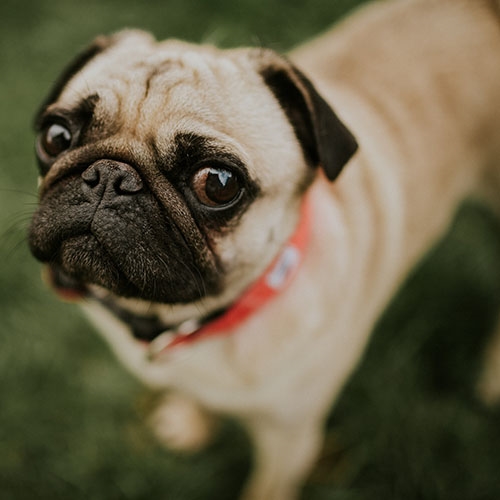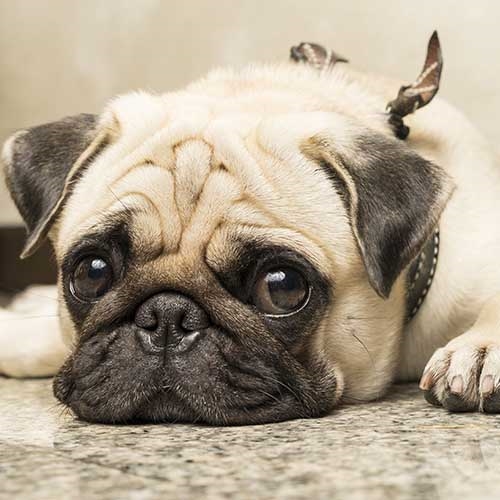Pug Breed Information
| Size | Small |
|---|---|
| Average height | 25-33 cm |
| Average weight | 6-8 kg |
| Average lifespan | Over 10 years |
| Minimum exercise (per day) | Less than 1 hour |
| Coat length | Short |
| Minimum cost (per month) | £50 |
Pugs are intelligent little dogs and very affectionate, making them a popular choice for owners. They love people and company and so can’t tolerate being left alone for any amount of time.
Although Pugs are affectionate dogs with big personalities, as they are a flat-faced breed they can have a lot of health problems. For this reason, if you own a Pug you’ll need to keep a close eye on them when exercising, especially in hot temperatures and be aware of what health problems to look out for. When thinking of getting a Pug, there are extra things you’ll want to look out for to make sure your dog will be as happy and healthy as possible.
Common health problems in Pugs
While Pugs are very sweet dogs and can make great pets, they are also a severely brachycephalic (flat-faced) breed. Pugs are in a group of breeds classed as ‘Category Three’ by The Kennel Club. This is the highest category of health concerns due to their physical conformation (the way they look). Breeding these types of dog over many years to look a certain way means they are very likely to suffer from serious health and welfare issues. For Pugs, this includes severe breathing difficulties, eye problems and skin problems.
Often, Breed Clubs will be able to provide advice on what tests your Pug may need and where to get these done. Make sure the parents of your puppy have had the relevant health screening to reduce the chances of these upsetting conditions affecting your puppy.
Due to the severity of health issues Pugs can develop and the impact these have on their quality of life, we always recommend thinking carefully before you buy or rescue a Pug. It’s important to put their welfare first and make sure you’re prepared for any health problems they might face.
However if you still want a Pug but you want to minimise the risk of your dog getting problems to do with exaggerated features, look for a dog or puppy with a longer nose and less skin folds on the face. You should also make sure that your puppy has had all the relevant screening tests for health conditions.
You can also read our advice on getting a pedigree or purebred pet.
Some of the conditions Pugs may develop include:
- Brachycephalic obstructive airway syndrome (BOAS) – this can cause severe breathing problems and is caused by their squished noses.
- A range of eye problems including dry eye (Keratoconjunctivitis sicca), eye infections, corneal ulcers or eye trauma due to shallow eye sockets
- Eyelid problems – entropion and ectropion can cause eyelids to fold inwards or outwards and irritate the eye.
- Skin infections particularly in the folds of skin around the face and tail.
- Luxating patellas – the kneecaps slipping temporarily out of place.
- Pug Dog Encephalitis (PDE) - A condition causing blindness, seizures and difficulty walking. These symptoms get progressively worse and eventually can be fatal.
- Hemivertebrae – this is a condition where the bones of the spine are deformed.
- Elbow dysplasia – there is BVA testing available for this
- Hip dysplasia – there is BVA testing available for this
- Legg Perthes disease
- Hypothyroidism
Caring for your Pug
Pugs can be highly entertaining dogs due to their big personalities and clownish nature. They generally do well in family environments where they have lots of company all of the time as they love to spend time with everybody. If they would have to be left alone in the house for a lot of the day, then they’re unlikely to be the right pet for you right now.
Remember to make sure your Pug doesn’t overdo it when walking or playing as they can easily become out of breath, made worse by their flat faces, causing breathing difficulties.
Pugs and barking
As with any dog, your Pug is likely to make noise in one form or another. How much your dog barks will be down to them as an individual. Some Pugs ‘huff’ rather than bark.
It’s important to differentiate between normal barks and huffs that your dog is making on purpose, and sounds such as snorts, snores and loud breathing that can be a sign of a common breathing problem in Pugs (BOAS). Speak to a vet if you’re hearing these breathing noises in your Pug.
If you’re having problems with excessive noise or barking, we recommend seeking the advice of an accredited behaviourist.
Training and socialisation
When it comes to training Pugs, although they are a clever breed they can also be very strong willed. Training needs to be ongoing and firm but fair. You can start positive, reward-based training from day one, whether you get your Pug old or young. You need to make sure everyone in the family follows the same training so your Pug doesn’t get confused or adopt behaviours you really don’t want.
Pugs adore company and don’t do well if left alone. We wouldn’t recommend leaving your Pug alone, but if you have to it should never be for longer than four hours and you should provide your Pug with toys they can safely play with on their own.
Exercise

Pugs can be prone to gaining weight that can make breathing problems worse, so it is important to keep them active and avoid any weight gain.
Your Pug will need up to an hour of exercise a day. This should include shorter walks, with extra playtime and lots of brain-stimulating activities. Several shorter walks throughout the day can help to stop them from becoming too tired or overheated, which is a great way to keep them active throughout the day.
Keep a close eye on your Pug as they can tire easily due to their difficulties getting enough oxygen. As soon as you start to notice them struggling to breathe, stop and make sure they get enough of a rest. You will also need to avoid exercising them in the heat as this can cause even more problems since they can be at higher risk of heatstroke. In warm weather, opt to walk them early in the morning or later in the evening when it’s cooler and make sure to keep an eye on them for early signs of overheating so you can stop before things get dangerous.
Grooming
Even though their coats are short, Pugs can still shed loads. Luckily, they tend to love being groomed as it means a lot of attention all on them.
You’ll need to brush your Pug’s coat at least once a week to keep it in good condition. If you bath your Pug, you’ll need to make sure you dry them off straight away so they don’t get cold. Pay close attention to the folds in their skin, as these are the perfect breeding ground for bacterial and fungal infections if left damp. You can teach your Pug from an early age to love tooth brushing and nail clipping so you can keep those pearly whites and paws in great condition.
Pugs and children
Pugs adore company and really love people of all ages. They often get on well with children, especially if the Pug loves to play. However, it’s best to keep an eye on them with children to make sure neither your Pug or children get too boisterous and end up accidentally hurting each other.
As with every breed, you should always teach children how to approach and play with dogs with care and kindness, to prevent any issues. Always supervise children and vulnerable people with your Pug and make sure you can recognise the signs of unhappiness or anxiety in your dog to help avoid any conflicts.
Pugs and other pets
Pugs are known for getting along well with other pets and dogs. If well-socialised, they’re usually very friendly towards people and other dogs and will often live happily with pets of all species – just make sure the other species are happy with them too! Introductions still need to be done carefully, though, just in case.
If your Pug is properly socialised there’s no reason they won’t get along with other dogs while you’re out and about. Good, kind training will also help them become well-rounded dogs that keep calm in new situations.
Food
Your Pug’s diet will vary depending on their age and any health conditions they may have. You’ll need to feed them a complete, commercially available dog food to keep them slim and healthy.
Your vet or vet nurse will be able to tell you how much your dog should be eating. It’s best to split their daily allowance into two meals to be given in the morning and evening. If you give your dog an occasional treat or use treats for training, remember to take this into account and reduce their daily food allowance. Treats shouldn’t make up more than 10% of their daily calorie intake or it can unbalance their diet.
Keep in mind that Pugs aren’t always the most active of dog and it can be easy for them to pile on the pounds, especially if they’re getting lots of treats. This can really impact on their breathing so it’s really important to avoid. Keep an eye on their weight and don’t regularly feed treats outside of training, as they will often eat anything and everything that comes their way.
You should try to feed your dog at the same time every day to get them into a routine. Remember to leave a gap after eating and before exercising.
The cost of owning a Pug

Having a Pug will cost a minimum of £50 per month after purchase and set-up costs and over £8,900 across its lifetime. Costs you’ll need to think about include:
Purchase costs
Adopting an adult dog from a rescue centre may be a more cost-effective option, with the added advantage of giving a home to a pet without one – check if the rehoming centre you’re looking at asks for a donation for rehoming.
If instead you’re buying a Pug puppy from a breeder, you’ll need to factor in this cost. Beware unusually cheap puppies as they could come from a puppy farm. If you’d like to buy a pedigree puppy, we recommend looking for a Kennel Club Assured breeder. These breeders must do extra health tests and meet higher standards for breeding.
It’s also a good idea to check for a few extra things when looking for a Pug puppy to make sure they’ll be as happy and healthy as possible as they grow. See our advice on what you need to know about flat faced pets and how to choose a healthier pedigree pet. You’ll want to look for a lively Pug puppy with nice, open nostrils, no noise when breathing, a visible tail that’s not ‘corkscrewed’, and skin folds you can gently pull back and see there is healthy skin underneath.
Set-up costs
- Puppy vaccines – if you rescue a dog, some centres will vaccinate them for you. Remember that ongoing booster vaccinations will be needed to continue their immunity.
- Neutering – you should usually arrange for your dog to be neutered at around six months old, though your vet will be able to advise you exactly when is best. Check prices at your local practice as these will depend on your vet and where you live. Some rescue centres will have already neutered the dogs they rehome where appropriate.
- Equipment – including a collar and tags, lead, harness, dog beds, dog bowls, pet-safe toothpaste and toothbrushes, grooming brushes and toys. Keep in mind that all these will need to be replaced with wear or if your dog outgrows them!
Ongoing costs
- Food.
- Preventive healthcare – budget for routine vet visits to help stop your dog getting ill and catching any problems early. They need annual check-ups, vaccinations and regular flea and worming treatments. Check if your vet offers a health care plan as this can help spread the cost throughout the year.
- Vet bills* or pet insurance – if you don’t have pet insurance and your dog needs veterinary treatment for an injury or illness, costs can rapidly mount up. Check what’s covered and what isn’t when comparing policies.
- Accessories – including lots of poo bags, replacing worn toys and grooming accessories, buying doggy toothpaste and any other extras they might need.
Other costs
- Training – basic training is very important and dogs can benefit from formal classes. Some dogs may have, or develop, behavioural problems which might need professional management.
- Boarding – you may also need to budget for boarding or dog sitting costs if you are planning to go away from home on holiday.
- Dog walkers/day-care – you might consider a professional dog walker to keep your dog happy and healthy if you’re unable to get out with your dog enough yourself, or to look after them during the day if you need to be out for more than four hours.
* It’s always better to plan ahead and budget or get pet insurance in case your pet gets injured or unwell. If you are having difficulty with veterinary costs, you can check if you are eligible for treatment at PDSA here.
If you’re considering pet insurance, our PDSA Pet Insurance could be a great option for you and it’s quick and easy to get a quote online.
Fun facts
- In the 19th Century, Queen Victoria was a big Pug fan and had several of her own.
- A group of Pugs is called a grumble!
- Pugs are an ancient breed, dating back to Ancient China where they were bred for Emperors. They were treated like royalty and the common people weren’t allowed to own them.
- Pugs were bred to be companions, which is why they love people so much. They weren’t bred to work, instead they were bred to keep their human company.
Getting a Pug
Do plenty of research before you get a Pug. Although they are loveable and friendly, they are sadly likely to get a lot of health issues (more so than many other breeds). Our vets would strongly recommend opting for a breed with a normal snout or even a Pug cross-breed instead and if you do decide you’d like to take on a Pug, make sure you are able to afford the possible vet bills that often come with owning a flat-faced breed before you commit to adopting one.
Rehoming centres
There are plenty of rescue centres across the country where you may find a Pug. Breed-specific rescues specialising in Pugs are out there too. You’ll need to ask any rescue centre about the dog’s history to make sure they will be comfortable in your home. Good rescue centres should let you know of any existing health and behaviour problems.
Breeders
If you buy from a breeder, make sure your puppy will have been well socialised and have all necessary health checks and vaccinations. We recommend looking for a Kennel Club Assured breeder as they meet higher standards. We’ve put together some advice to help you find a good breeder.
Make sure to pick a puppy whose parents’ flat-face, skin folds and breathing problems are less pronounced as this will reduce the likelihood of your pug having as many breed-related problems.
Again, we’d strongly advise getting looking for a healthier cross breed rather than a pure-bred Pug.








